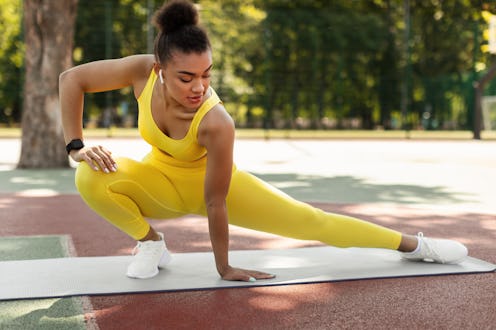
In the land of FitTok, you’ll find a wide range of grueling ab challenges, cardio workouts, and videos of people showing off how much weight they can lift. On the more gentle end of the spectrum, however, mobility training has taken TikTok by storm: The hashtag #mobilityTikTok has already racked up over 35 million views and shows folks promoting stretchy routines as a way to feel more flexible and, well, mobile.
At its core, mobility training is all about ensuring you move well. In fitness terms: “Mobility is the ability of the body to move seamlessly, without pain or discomfort, throughout full ranges of motion,” says Hannah Daugherty, a NASM- and ACE-certified personal trainer and health coach. “When the muscles move well, the joints will follow, since the muscles are attached to said joints.” Think rotating your arms in a full circle without shoulder pain, or being able to squat down low without your hips crunching.
Mobility training isn’t solely meant to be a remedy, though — experts (and now TikTok) recommend it as part of a healthy, well-rounded fitness routine. It’s what you’d do if your mobility is impeded, sure, but also if you sit a lot during the day or exercise on a regular basis without following up with a stretch. Or if you simply want to improve your body’s longevity. Mobility routines help undo all the more high-impact or muscle-shortening activities you do by loosening up stiff muscles and “oiling” your joints so that everything can run smoothly again.
Improved mobility can ease pain, make it easier to work out, and help you move “fluidly” through everyday life, Daugherty says. If that sounds like a dream, then here are a few stretches straight from #mobilityTikTok to get you started.
Mobility Training From TikTok
This mobility exercise from @ellie_nem is a variation of a hip opener, Daugherty says, which could be beneficial if you have tight hips or lower back pain. To do it, windshield-wiper your knees back and forth. If you want extra hip flexor love, add a lift by kneeling halfway through.
This move from @fer.u will also open your hips so you can move freely, do squats with abandon, and feel better after sitting for long periods of time. “Depending upon the exercises being performed, mobility exercises can be a wonderful addition to a workout program when done as part of a dynamic warmup or as part of a cool-down segment once the body is already warm,” Daugherty says.
You could also do squats to stands, prying goblet squats, cossack stretches, dynamic 90-90s, quadruped hip circles, or lying quad stretches with a reach, as demonstrated by @kellylmatthews — all feel-good remedies for a tight lower body.
To get rid of “crunchy” shoulders that crack and pop, try moves like arm screws, banded around the worlds, or a dead hang from a pull-up bar. It might also feel really good to get on all fours and “thread the needle” by sticking your arm under your armpit to open your upper back.
For tight ankles, hamstrings, and hips, try moves like pike toe raises and pike heel raises to stretch out your posterior chain, à la @vanjamoves. While it’ll depend on the reason why you’re stiff, Daugherty says consistent mobility training should have you feeling all loose and free in three to five weeks.
It’s all about the practice of moving your body through its full range of motion on a regular basis. “Mobility work can be done daily,” she adds, as long as you aren’t injured or it doesn’t hurt. So if these moves are calling your name, pop on down and give them a try.
Source:
Hannah Daugherty, NASM- and ACE-certified personal trainer and health coach